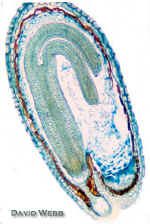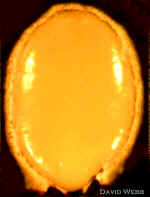
The
seed represents one of the most significant plant adaptations. The Seed develops from
the Ovule. The Ovule's Integuments form the Seed Coat. The Seed coat protects the enclosed
propagule. In some cases, an impervious seed coat contributes mightily to seed longevity.
This spreads germination over a long time-span. In non-seed plants, sexual propagules must
sink or swim. They either survive or die in a single season. The ability to spread
reproduction over a long time-span also contributes to long distance transport of seeds
which helps to extend their range. The founding seeds which colonized the Hawaiian Islands
had to cover many thousands of miles of air and water to get here. In many cases this was
aided by animal dispersal. This can be due to ingestion or by adherence to the feathers of
birds or other beasts. Some seeds float and can withstand long exposure to salt water. The
coconut is a good example of this and it can spread naturally over the ocean.
adaptations. The Seed develops from
the Ovule. The Ovule's Integuments form the Seed Coat. The Seed coat protects the enclosed
propagule. In some cases, an impervious seed coat contributes mightily to seed longevity.
This spreads germination over a long time-span. In non-seed plants, sexual propagules must
sink or swim. They either survive or die in a single season. The ability to spread
reproduction over a long time-span also contributes to long distance transport of seeds
which helps to extend their range. The founding seeds which colonized the Hawaiian Islands
had to cover many thousands of miles of air and water to get here. In many cases this was
aided by animal dispersal. This can be due to ingestion or by adherence to the feathers of
birds or other beasts. Some seeds float and can withstand long exposure to salt water. The
coconut is a good example of this and it can spread naturally over the ocean.
The Seed contains
the Embryo and may also contain  Endosperm. The latter is a nutritive tissue that is
used by the embryo during its development, and may also be used during germination.
Coconut "milk" and "meat" are liquid and solid Endosperm respectively.
Some seeds lack a prominent endosperm and store their reserve in large Cotyledons. Most
legumes like beans and peas have large Cotyledons. These have become staples in he diets
of humans. Farmers build Civilizations!
Endosperm. The latter is a nutritive tissue that is
used by the embryo during its development, and may also be used during germination.
Coconut "milk" and "meat" are liquid and solid Endosperm respectively.
Some seeds lack a prominent endosperm and store their reserve in large Cotyledons. Most
legumes like beans and peas have large Cotyledons. These have become staples in he diets
of humans. Farmers build Civilizations!
In order to understand Seed formation we need to go back to the double fertilization event in the Lily Life Cycle. All right Mr. Peabody, the way-back machine is primed and ready to go!